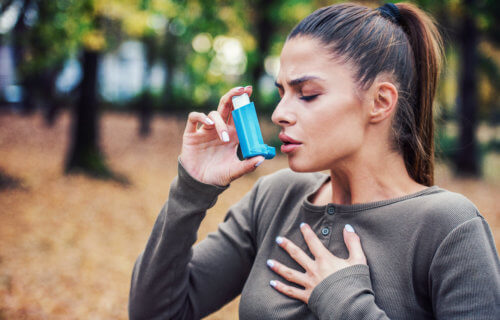RALEIGH, N.C. — In an effort to prevent another viral pandemic, scientists are developing ways to protect the lungs from infection — from the inside out. A new animal study by researchers at North Carolina State University is revealing the success of using an inhalable powder to protect the mucosal layer of the lungs. This drug could keep people healthy during flu season and even block infection from COVID-19.
“The idea behind this work is simple – viruses have to penetrate the mucus in order to reach and infect the cells, so we’ve created an inhalable bioadhesive that combines with your own mucus to prevent viruses from getting to your lung cells,” says corresponding author Ke Cheng in a university release. “Mucus is the body’s natural hydrogel barrier; we are just enhancing that barrier.”
What’s in SHIELD?
The powder is called Spherical Hydrogel Inhalation for Enhanced Lung Defense — or SHIELD for short. Study authors demonstrated that it lowers the risk of viral infection when applied to mouse and non-human primate models over a 24-hour period. The SHIELD powder isn’t just a one-and-done medication either. The study results show it can protect patients multiple times without affecting lung function.
The inhalable powder contains microparticles consisting of gelatin and poly(acrylic acid) implanted with a non-toxic ester. When the powder enters a moist environment — like a person’s airways — the microparticles expand and stick to the mucosal layer, creating a stickier mucus residue. The powder’s effects are strongest in the first eight hours after inhalation. It takes about two days for SHIELD to fully clear the body.
Mice inhaling the SHIELD were protected against particles similar to the COVID virus. The powder showed a 75-percent efficiency four hours after inhalation. After 24 hours, the efficiency dropped to 18 percent. Scientists saw similar levels of protection against the viruses that cause pneumonia and swine flu. Among primate test subjects, those receiving SHIELD were more protected against the original and Delta COVID-19 variants.
SHIELD blocks COVID-related lung damage
The researchers also studied viral load (how many virus particles are present in the body) since primates do not show the same symptoms of infections as humans. Viral load is a common marker to determine exposure to a virus.
Primates taking SHIELD showed a reduced 50 to 300-fold viral load than primates not taking the inhalable powder. Additionally, primates with SHIELD protection showed no lung-related symptoms which the COVID virus usually causes, such as lung inflammation or fibrosis. The team looked at how the powder affected cells on an individual level. Using cell cultures, the scientists saw that about 95 percent of cell cultures exposed to SHIELD remained healthy with no signs of toxicity. Mice given daily doses of the powder for two weeks also showed no changes in their lungs and respiratory function.
“SHIELD is easier and safer to use than other physical barriers or anti-virus chemicals,” Cheng says. “It works like an ‘invisible mask’ for people in situations where masking is difficult, for example during heavy exercise, while eating or drinking, or in close social interactions. People can also use SHIELD on top of physical masking to have better protection.”
While the SHIELD powder is intended to treat infectious viruses like COVID and the flu, that may not be the case in the future. The research team is looking to expand SHIELD’s use to protect against lung irritants found in allergens and air pollution.
“Anything that could potentially harm the lungs,” Cheng cautions.
The study is published in the journal Nature Materials.


Does the SHIELD have FDA approval?
If you reduce the viral one time it would be zero. You can increace something an infinate amount, but you can only reduce one fold(100%).
Is every scientist math retarded!